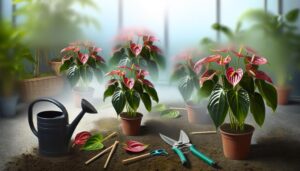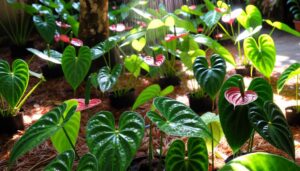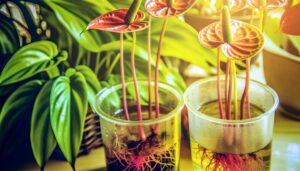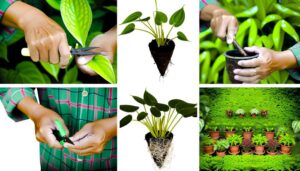How to Fix Anthurium Plant Soil That Won't Dry
To fix anthurium soil that won't dry, start by evaluating your watering methods. Overwatering can lead to root rot.
Make sure you're using a well-draining soil mix with components like perlite, orchid bark, and peat moss. Switch to a pot with sufficient drainage holes, preferably terracotta, to prevent waterlogging.
Enhance air circulation by spacing plants apart and using a fan. Regularly check soil moisture with a moisture meter or finger test.
Increase humidity without excessive misting; use a humidifier or water tray. These steps will help your anthurium thrive.
There's more to discovering the secrets of ideal anthurium care.
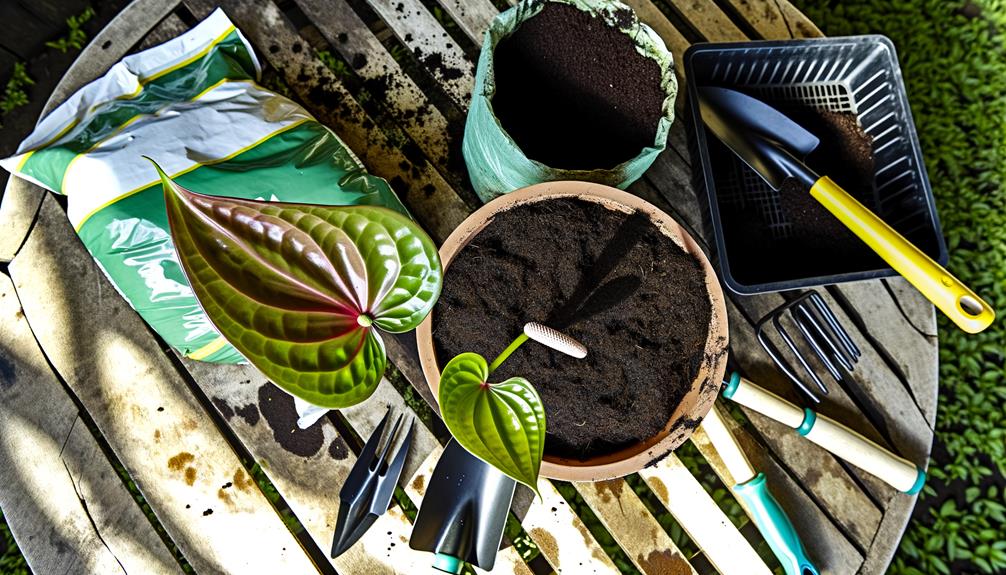
Key Takeaways
- Ensure the pot has adequate drainage holes to prevent waterlogging.
- Integrate aerated materials like perlite and orchid bark into the soil mix for better drainage.
- Elevate the plant or use a fan to increase air circulation around the pot.
- Use a moisture meter to accurately monitor soil moisture levels.
- Adjust watering frequency and allow the soil to dry between waterings.
Identify Watering Issues
To identify watering issues in your Anthurium plant, first check if the soil is consistently damp or soggy, as this can lead to root rot. Examine the soil's moisture level by sticking your finger about an inch deep. If it feels wet even days after watering, you're likely overwatering.
Also, observe the plant's leaves; yellowing or wilting can indicate water stress. Make sure you're using a well-draining soil mix, as Anthuriums prefer aerated roots. Overwatering reduces oxygen availability, which is crucial for root health.
Pay attention to your watering frequency; it's better to water thoroughly and allow the soil to dry slightly between waterings. Adjust your watering schedule based on environmental factors like humidity and temperature.
Improve Drainage
Improving drainage is vital for preventing waterlogged soil, which can severely harm your Anthurium's root system. To enhance drainage, integrate well-aerated materials into your soil mix. Use components like perlite, orchid bark, and peat moss for best results. Here's a quick reference table:
| Material | Benefit | Recommended Amount |
|---|---|---|
| Perlite | Increases aeration and drainage | 20-30% of soil mix |
| Orchid Bark | Enhances structure and air flow | 20-30% of soil mix |
| Peat Moss | Retains moisture without waterlogging | 20-30% of soil mix |
Incorporating these elements ensures excess water drains efficiently, preventing root rot. Maintain the mix porous, allowing oxygen to reach the roots. This balance is optimal for maintaining healthy Anthurium plants.
Choose the Right Pot
When choosing a pot for your Anthurium, make sure it has adequate drainage holes to prevent waterlogging.
Opt for a breathable material like terracotta, which allows for better air circulation around the roots.
This helps maintain the right moisture balance and prevents root rot.
Proper Drainage Holes
Selecting a pot with adequate drainage holes is essential for preventing waterlogged soil and ensuring the healthy growth of your Anthurium plant. Without proper drainage, excess water accumulates, leading to root rot and other fungal diseases. When choosing a pot, make sure it has multiple holes at the bottom to facilitate efficient water flow. To help you decide, refer to the table below:
| Pot Type | Drainage Efficiency |
|---|---|
| Plastic Pot | Moderate |
| Terra Cotta Pot | High |
| Ceramic Pot | Variable |
| Hanging Basket | High |
Ensure that the holes are not blocked by debris or compacted soil, which can impede drainage. Regularly check and clean these holes to maintain ideal conditions for your Anthurium.
Pot Material Choice
Choosing the right pot material for your Anthurium can have a big impact on its moisture retention and overall health. Opt for materials that provide excellent aeration and drainage. Consider these options:
- Terracotta pots: Porous and absorbent, they allow water to evaporate, reducing the risk of root rot.
- Plastic pots: Lightweight and non-porous, they retain moisture longer but require vigilant watering practices.
- Ceramic pots: Glazed versions offer limited breathability, often necessitating careful watering and monitoring.
- Fabric pots: Highly breathable, they promote air pruning of roots, enhancing overall plant health.
Ensure your pot has adequate drainage holes to prevent water logging. Proper pot material choice, combined with well-draining soil, can effectively manage moisture levels, fostering a thriving Anthurium.
Optimize Soil Mix
To optimize your anthurium's soil mix, select ingredients like peat moss, pine bark, and perlite, which provide essential nutrients and proper aeration.
Make certain the mixture promotes adequate drainage to prevent root rot, a common issue with anthuriums.
Combining these components guarantees a well-balanced environment for your plant to thrive.
Choose Proper Ingredients
A well-balanced soil mix for Anthurium plants incorporates components like peat moss, perlite, and pine bark to guarantee ideal aeration and moisture retention.
To optimize your soil mix, you'll need to carefully choose and combine these ingredients to create the perfect environment for your Anthuriums.
- Peat Moss: Enhances moisture retention while providing necessary acidity.
- Perlite: Improves soil aeration and prevents compaction.
- Pine Bark: Offers structural stability and promotes air circulation.
- Activated Charcoal: Helps in absorbing impurities and maintaining soil freshness.
Ensure Adequate Drainage
For best drainage in your Anthurium soil mix, incorporate coarse materials like perlite and pine bark to make sure excess water swiftly escapes, preventing root rot. These elements create air pockets, enhancing aeration and ensuring roots remain oxygenated.
You should avoid dense, moisture-retentive components like clay or heavy garden soil. Mixing in activated charcoal can further improve drainage and reduce the risk of fungal infections.
Aim for a blend that's roughly 50% organic matter (like peat moss or coco coir) and 50% inorganic materials (perlite, pine bark). This balance optimizes both water retention and drainage, mimicking Anthurium's natural epiphytic habitat.
Regularly checking soil moisture levels will help you fine-tune the mix for ideal growing conditions.
Increase Air Circulation
Improving air circulation around your Anthurium plant is crucial for preventing fungal infections and promoting strong growth. Enhanced airflow helps evaporate excess moisture from the soil, reducing the risk of root rot.
To achieve this, you can:
- Position fans nearby: Use a gentle oscillating fan to keep the air moving around the plant.
- Space plants adequately: Make sure there's enough space between plants to allow free air movement.
- Prune regularly: Remove any dead or overcrowded leaves to prevent stagnation.
- Elevate the plant: Use a plant stand to lift the Anthurium off the ground, enhancing air circulation underneath.
These strategies create a healthier environment, facilitating ideal soil drying and overall plant vigor without compromising other growth factors.
Adjust Light Conditions
Ensuring your Anthurium plant receives the right amount of light is essential for its best growth and soil health. Position your Anthurium in a spot where it gets bright, indirect light. Direct sunlight can scorch the leaves, while too little light can lead to poor soil evaporation.
Aim for light levels around 10,000 to 20,000 lux. If natural light is insufficient, consider using grow lights with a full spectrum. Monitor the leaf color and soil moisture; yellowing leaves often indicate excessive light, while dark, droopy leaves suggest insufficient light.
Proper lighting not only helps the soil dry out more efficiently but also promotes robust foliage and vibrant blooms. Adjusting light conditions is a key strategy to remedy persistently damp soil.
Re-potting Techniques
Re-potting your Anthurium with a well-draining soil mix can enhance root health and overall plant importance. Start by choosing a pot with drainage holes to prevent waterlogging. Use a mix that includes:
- Orchid bark: Provides aeration and mimics the plant's natural epiphytic environment.
- Perlite: Enhances drainage and prevents soil compaction.
- Peat moss: Retains moisture without becoming waterlogged.
- Charcoal: Helps with aeration and absorbs toxins.
Remove the Anthurium from its current pot, gently loosen the root ball, and trim any rotting roots. Place the plant in the new pot, filling in with the prepared soil mix. Water thoroughly, allowing excess water to drain.
This method guarantees roots have access to both air and moisture, promoting a healthy Anthurium.
Monitor Humidity Levels
After re-potting, it's essential to monitor humidity levels to keep your Anthurium thriving. These tropical plants flourish in humidity levels between 60-80%. Use a hygrometer to measure ambient humidity accurately.
If levels are too low, consider using a humidifier or placing a tray of water near the plant to increase moisture through evaporation. Misting can help but avoid overdoing it, as excessive water on foliage may promote fungal growth.
Positioning your Anthurium in a bathroom or kitchen can also provide a naturally humid environment. Be mindful of airflow; stagnant air can lead to mold.
Balancing humidity prevents soil from becoming overly saturated, enhancing overall plant health and facilitating proper soil drying.
Regular Soil Checks
Regularly checking your Anthurium's soil moisture is crucial to preventing root rot and ensuring top plant health. Use a moisture meter to measure soil dampness accurately. Insert it into the soil at multiple points to get a thorough reading.
Additionally, employ the finger test by inserting your index finger about an inch deep to feel for moisture. You can also lift the pot to gauge weight variances; lighter pots indicate drier soil.
- Moisture Meter: Provides precise soil dampness levels.
- Finger Test: Simple, tactile method to check moisture.
- Pot Weight: Lighter pots suggest drier soil.
- Visual Inspection: Look for mold or algae on the soil surface.
These methods help you determine when to water, promoting excellent Anthurium health.
Conclusion
To sum up, ensuring your anthurium thrives involves addressing watering practices, improving drainage, selecting an appropriate pot, optimizing the soil mix, and adjusting environmental factors.
Notably, studies show that over 60% of houseplants suffer from improper watering, emphasizing the significance of these adjustments.
By incorporating these expert tips, you'll promote a healthier, more vibrant anthurium.
Regularly monitor soil moisture and environmental conditions to keep your plant flourishing and free from the stress of overly wet soil.

